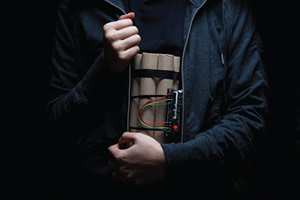Planning Your School's Response To A Terrorist Attack
- By Michael Fickes
- 01/01/16

PHOTO © GONGTO/SHUTTERSTOCK
The month of December 2015 underlined a national nightmare: the threat of violent attacks on schools.
The nation’s two largest school districts, Los Angeles and New York City, both received violent threats. The Los Angeles threat caused the city’s schools to close for a day. New York City’s schools remained open, in a move that made all of us hold our breath.
Next came threats against the two largest high schools in Nashua, N. H., causing that city to close its public schools for a day.
The number of violent threats against schools has skyrocketed. By one count, schools in 46 states have received more than 800 threats violent since the beginning of this school year in September. Nearly half of those threats involve bombs.
The Macon, Ga.-based Safe Havens International, a non-profit school safety consulting and service firm, has identified 37 terrorist attacks on schools around the world between 1970 and 2004. That’s an average of just over one attack per year.
Descriptions of these attacks are chilling. In May of 1986, for instance, a married couple with extremist views attacked an elementary school in Cokeville, Wyo. Carrying firearms and explosives, they took students and teachers hostage.
In August of 1999, another extremist attacked a childcare area of a Jewish Community Center in Los Angeles. He killed several children and a Hispanic postal employee. Police attributed his actions to anti-Semitic and racist views.
Schools of all kinds are subject to attack. In November of 2004, a bomb blast damaged a Muslim elementary school in The Netherlands. While no one was injured, the police speculated that the attack related to other terrorist incidents occurring around the area.
How can you prepare the schools in your district? “In fact, security plans don’t have a tab for terrorism,” says Michael Dorn, executive director with Safe Havens International. “Security tabs are situational. The tabs that might apply to terrorism include bomb threats, active shooters, chemical weapons attacks and the like.
“Fortunately, a lot of the things you should do to prepare for a terrorist attack are also good for other kinds of events, such as fires, tornados and active shooters.
“A good security plan covers all of the kinds of attacks that happened in Paris.
“On the other hand, it is important to point out that if you have a security plan that talks all about active shooters and nothing else, you aren’t prepared. What if something happens that doesn’t involve an active shooter? What is your plan to respond to bomb threats and hazardous material releases? What is your shelter-in-place protocol?”
Dorn suggests a six-step security plan to help prevent terrorist attacks.
- Security training for school staff and faculty — from administrator to teachers to custodians — with an emphasis on the fundamentals of access control, visitor management and video.
- Security is surely not everything or even most things, but it is definitely part of the job of working in education today. So you have to build a security-sensitive culture. Expensive investments in security technology become worthless when someone props open a door or fails to follow other protocols. Buy-in by and support from top leaders is the way to build an effective security culture.
- Behavioral pattern training. An alternative to profiling individuals, behavioral pattern matching is a technique that looks for patterns of behavior characteristic of individuals planning an attack. Generally speaking, these are behaviors that don’t fit with the setting or environment — behaviors that make an individual stand out.
- Protect information. Terrorists, like all intelligent criminals, investigate their targets. In the Cokeville shooting mentioned above, the husband and wife culprits cased the school for a week before attacking. They figured out how to get around the fences, security cameras and visitor management systems designed to limit access to unwanted visitors.
- Protect your facilities from Internet surveillance, too. Many schools keep campus maps and building layouts online. Perhaps it would be better to only email those documents to those who need them. Security information needs protecting as well. Hackers can get into security systems and use your schools’ cameras to look around.
- See something; say something. The Department of Homeland Security constantly preaches the message: if you see something, say something. There are training courses that you can use to teach what constitutes suspicious behavior that you should see and say something about.
Then again, the overall goal of a security plan is not to turn a school into a locked down prison. Security measures and technology must be sufficient, but the most important part of security, say the professionals, is education and communications that enable everyone to put security to use.
“In Pakistan, for instance, a school custodian’s security training enabled him to detect a suicide bomber planning to detonate a bomb at the school,” Dorn says. “As the bomber approached the school, the custodian threw himself at the bomber and exploded the bomb. He died but saved a lot of lives.”
Dorn worries about canned, off-the-shelf emergency plans, calling them oversimplified. “We consult with districts that have plans that fail to cover hazardous materials, biological attacks or radiological incidents,” he says. “If your plan covers gunmen, fire and bad weather and leaves out these other events, it isn’t good enough.”
Dorn offers a final somewhat contradictory observation, noting that school emergency plans have declined in quality in recent years — thanks to an over emphasis on school shootings. While that may sound surprising in light of current events, Dorn points out that security is more than protecting against shooters.
“Security plans were better before Sandy Hook,” he says. “Since then, there has been too much of a focus on gunmen and the run, hide and fight idea. We can’t forget about everything but shooters. Good security is a lot more than that.”
This article originally appeared in the issue of .